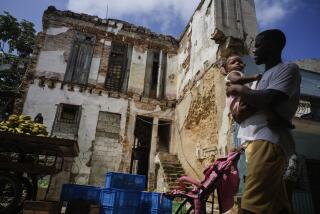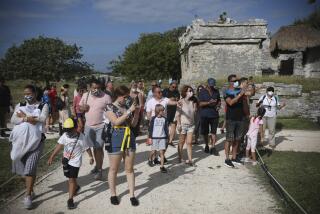Cuba Warms to Resorts--on Cash Basis : In Search of Hard Currency, Castro Opens Beaches to Foreigners
- Share via
BACONAO, Cuba — Luxury resorts that are fit for capitalists but off-limits to ordinary Cubans are sprouting like beach umbrellas throughout Cuba, lending a distinctly incongruous air to the hard-line Communist country’s austere and morally stringent revolution.
Topless and sometimes nude bathers from Canada, Western Europe and Latin America frolic and sunbathe on the soft, white sand beaches of Cayo Largo, a small island that guards the Bay of Pigs. Foreign yachts and executive jets slip smoothly in and out of the island’s marina and airport, but Cubans are barred. Like most of Cuba’s new tourist developments, Cayo Largo is only for customers with hard currency, meaning mainly cash.
That’s the bottom line here--hard currency. Almost totally dependent on the Soviet Union and other East Bloc countries for support, Havana has all but run out of hard currency with which to pay for vital machinery, spare parts and raw materials that are available only in the West.
The country does a brisk but small business with Eastern European visitors--about 30,000 a year, according to Rafael Sed Perez, who heads the National Institute of Tourism or INTUR--but they pay with soft currencies such as the Soviet ruble and the Polish zloty that can be spent only in the East Bloc.
Daiquiris and Mojitos
Even sugar production, the island’s mainstay, has sagged. This has forced Cuba to the embarrassing and costly extreme of paying scarce dollars on the open market for supplemental foreign sugar to meet the demanding quota that it must send each year to Moscow under a low-paying, long-term contract.
To fill the foreign exchange gap, Cuba began three years ago to develop new resorts and rehabilitate old ones that had gone to seed after Fidel Castro’s rise to power nearly 30 years ago.
Already, here in Baconao, a hodgepodge tourist strip that runs for 30 miles west of Santiago de Cuba on the southeast coast, foreigners with dollars can float onto submerged bar stools at the seaside Hotel Bucanero’s swimming pool, and--without emerging from the water--sip daiquiris and mojitos, a kind of rum mint julep that is the Cuban national drink.
Dotted with small seaside hotels for fishermen, snorkelers and sunbathers, the Baconao strip also features roadside attractions, including a jarringly misplaced dinosaur park and a trained-porpoise aquarium.
At Varadero, a 1950s prime attraction that boasts some of the Caribbean’s finest beaches, a new international airport is under construction, and there are plans to expand the 2,800-bed tourist capacity to more than 10 times that number.
Just describing that goal in a recent speech made the anti-capitalist Castro sound like a character out of the film “Wall Street.”
“If we earned $37 million (in 1987) with less than 3,000 rooms, imagine that Varadero one day has 30,000 rooms. We can earn 10 times more,” he said. “We can earn $400 million, $500 million, $600 million or $700 million in Varadero.”
From Boom to Bust
For Castro, that statement represents an about-face. The Cuban tourist industry, which thrived until 1959 on upward of 300,000 annual visitors from the United States, went from boom to total bust overnight when the puritanical revolutionary government shut it down--avowedly forever.
At the time, Castro cited pre-1959 Cuban tourism, with its heavy emphasis on gambling, prostitution and political corruption, as one of the main reasons for the revolution. Luxury hotels in Havana and resorts elsewhere in the country were allowed to waste away.
“Under capitalism, it was an easy thing to set up a whorehouse,” the Cuban leader recalled with distaste at a recent mass gathering in Varadero. “Tourism here was one of prostitution. That’s over now. A tourism of gambling. A tourism of drugs. There’s nothing of that here, nor ever will be.”
The Cuban leader justified the country’s return to tourism now on grounds that it would be folly in the face of a cash shortage to ignore Cuba’s natural resources.
Speaking of the Varadero beaches, he asked, “What would France do if it had those 115 kilometers of tropical beaches with that sun, with those clear and quite clean waters? It is a natural resource for our country and we must think of ways to exploit it intelligently and revolutionarily. It will be a tourism that will not be based on those three things I mentioned: prostitution, drugs and gambling.”
While the natural resources are spectacular, tourism officials acknowledge with regret that the trained manpower resources are not. Most of the chefs, waiters and hotel employees who knew how to coddle big spenders in the old days have either left long since for Miami or are too old to start again.
Many of the new workers behave as if 30 years of revolutionary education taught them that serving the leisure class is demeaning and counterrevolutionary, but it does offer them the opportunity to pick up some hard currency through tips and other means. Even in the showcase Bucanero, where special efforts have been made to train the staff, pool-side drinkers may drown before a bartender deigns to notice them, and diners in the airless hotel restaurant are likely to be met by hostile indifference when they try to order.
‘Food Is Awful’
“The sun, the sea, the atmosphere are wonderful, but the food is awful,” said Kristian Jorgensen, 20, a Danish student who came to Cuba with two classmates for a summer month of relaxation in socialist sand and sun.
According to INTUR President Sed, a 40-year-old whiz kid plucked for the important tourism job from Castro’s tight inner circle of advisers, two schools have been established for tourist industry workers, technicians and managers in what amounts to a crash program to bring resort and hotel services up to international standards.
“They must be the best workers, the most disciplined,” he said, adding that new labor rules will soon permit managers to fire employees who do not “learn how to pay attention to tourists, how to sell.”
The Communist government hopes to add further expertise to its budding tourist industry through joint ventures with foreign hotel, restaurant and resort operators, but so far it has had little success because it insists on majority control and strict limits on the amount of hard currency profits that can be repatriated.
“Right now, we’re just getting started. The quality of service is not good; we must do better,” said Bienvenido Abierno, a Foreign Ministry official who has lived and traveled abroad and candidly admits that Cuba’s hotel and resort standards are now too low.
193,000 Travelers
Even so, INTUR claims that the tourist market is expanding. According to Sed, 193,000 travelers from hard currency countries came last year. The largest group, about 50,000, were Canadians who can buy a 10-day package including two meals a day for about $600 Canadian (about U.S. $495) including air fare. Next came the West Germans (25,000) and Spaniards (13,000), according to INTUR statistics.
The target date for the new, improved Cuban tourism is 1991, said Sed, so the country can be ready for an expected influx of visitors to the Pan American Games and in 1992 for celebrations marking the 500th anniversary of Christopher Columbus’ discovery of the Americas.
Cuba expects to expand its nationwide tourist capacity by then from the current 14,300 rooms to 19,100 rooms and draw as many as 600,000 visitors, Sed said. It hopes to raise tourism income from $117 million last year to $500 million.
Some foreigners here say the goal may be a pipe dream unless there is a startling change in U.S.-Cuba relations that will open Cuba travel to Americans. At present, U.S. citizens cannot be prevented from going to Cuba but, unless they are journalists on assignment or professionals with State Department permission, they can be prosecuted for spending money in the country.
“We would like them to come,” said Sed, “as we want people to come from all over the world. The income would be much greater, and it would allow them to know the reality of Cuba. I think the impression they get (in the United States) is quite different from the reality.”
More to Read
Sign up for Essential California
The most important California stories and recommendations in your inbox every morning.
You may occasionally receive promotional content from the Los Angeles Times.










